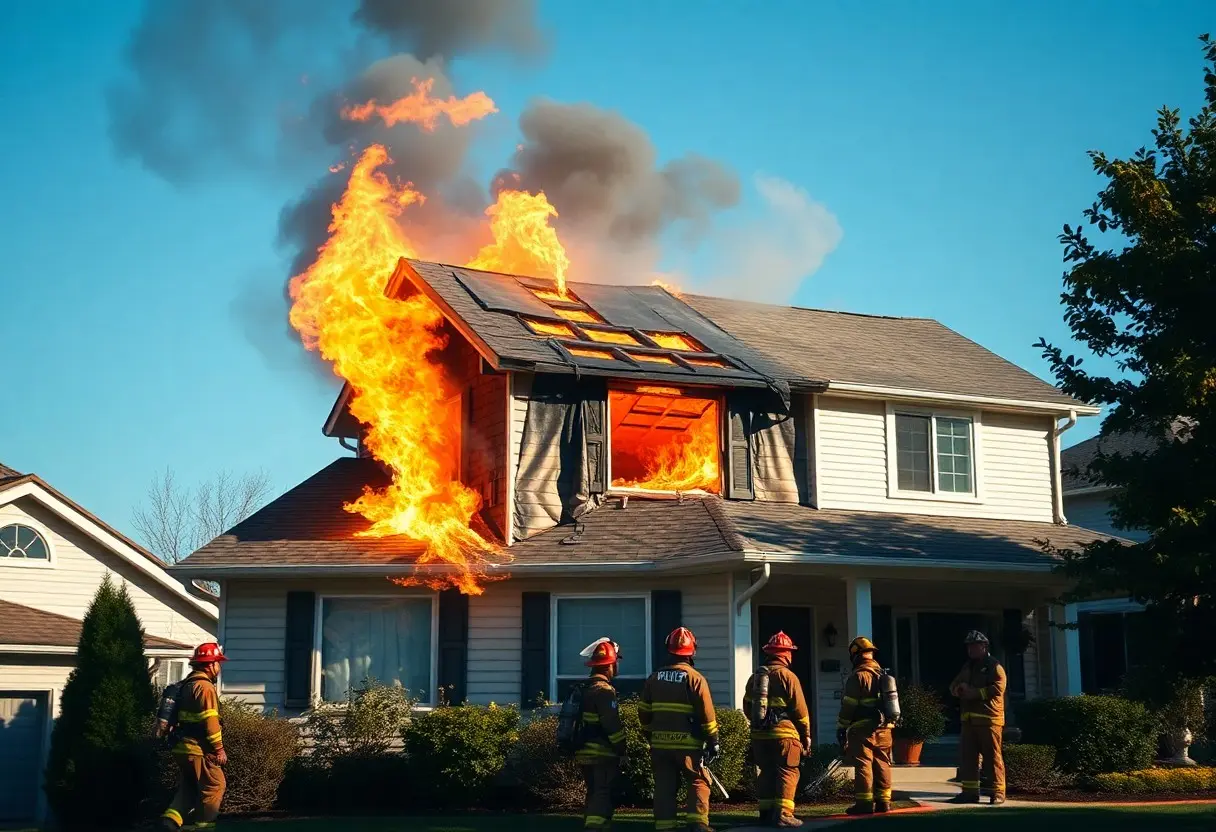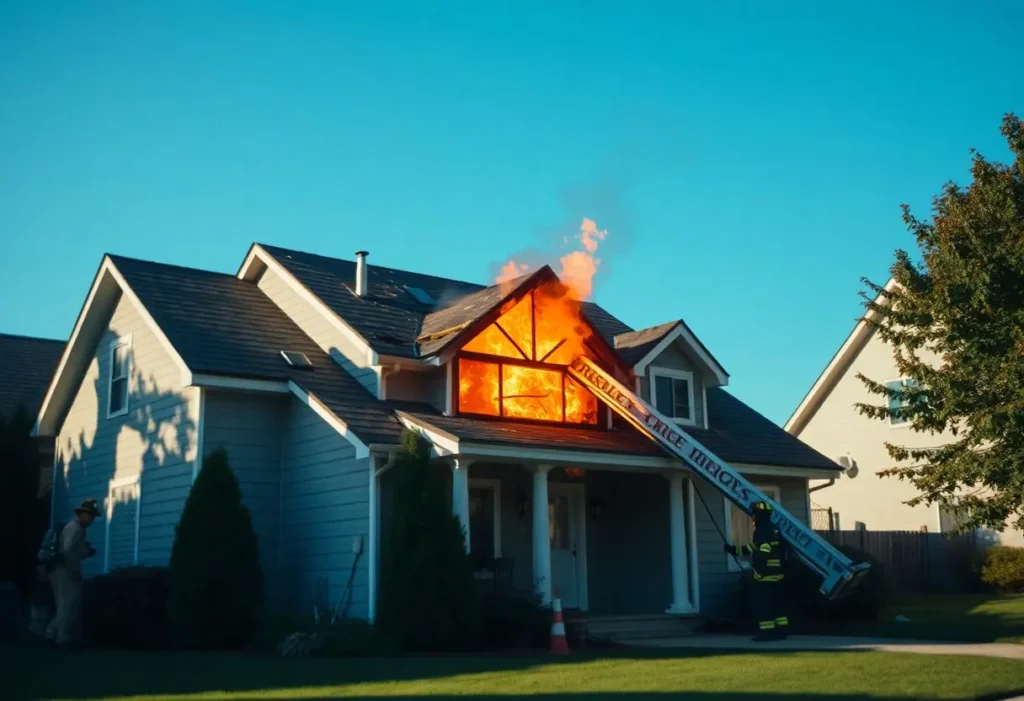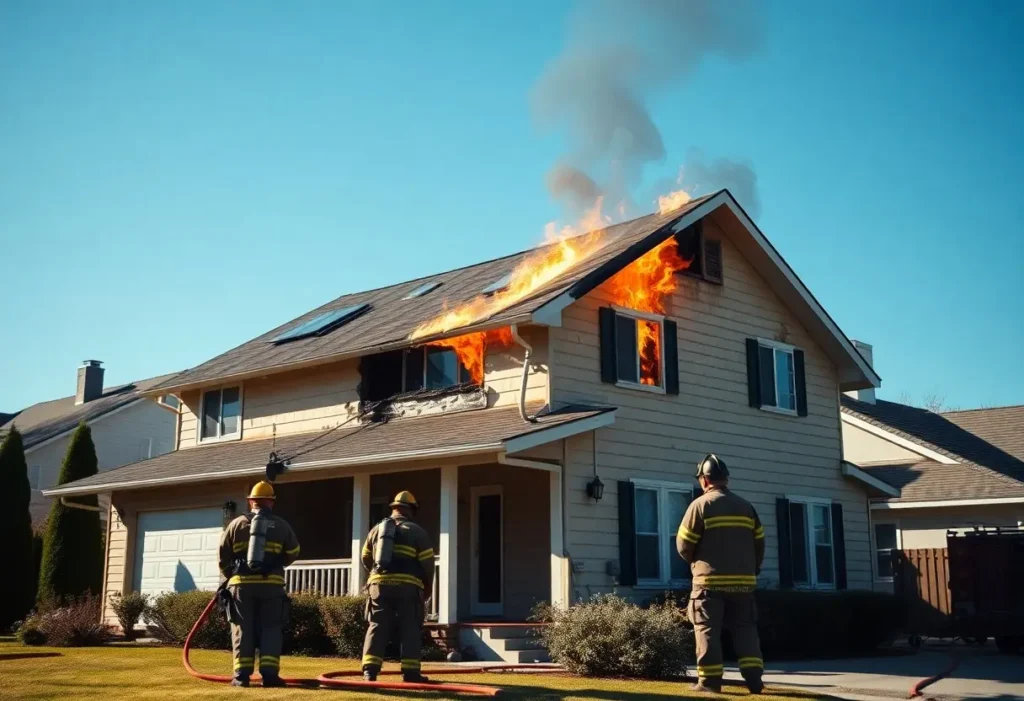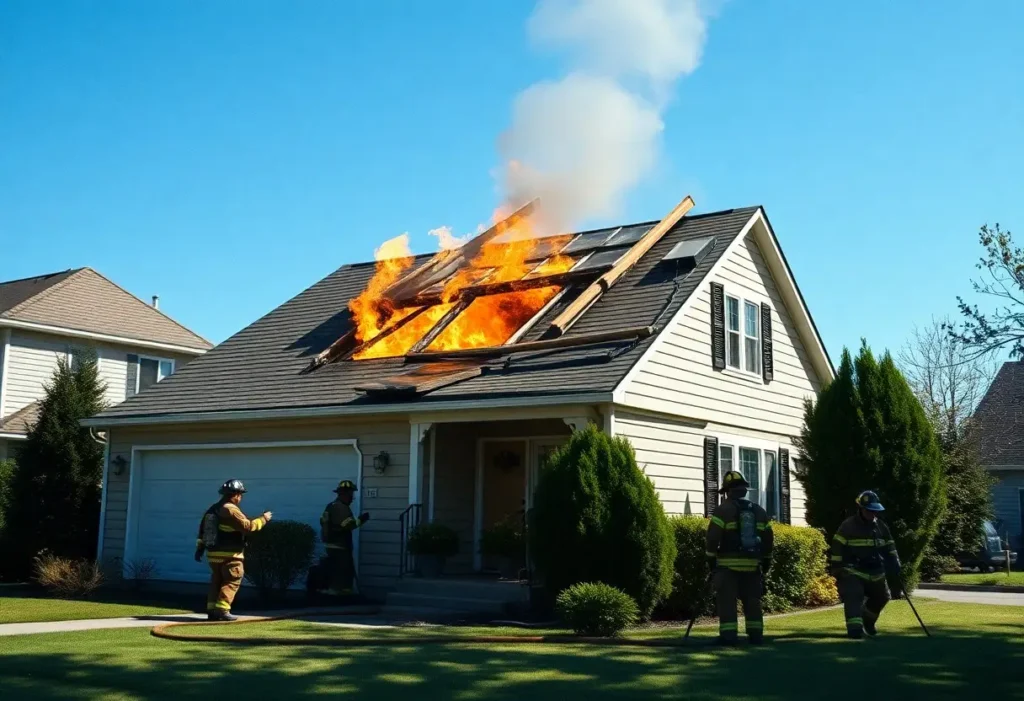The Roof Was On Fire? Causes and Prevention Tips For Home Safety

While “the roof was on fire” is often a dramatic figure of speech, it’s a real and terrifying possibility for homeowners. A fire starting on your roof can spread with shocking speed, endangering your family and causing catastrophic damage.
In this blog post, we’ll dive into the common causes of roof fires and provide you with essential prevention tips to keep your home and loved ones safe. By understanding the risks and taking proactive steps, you can significantly reduce the chances of this devastating event.
Key Takeaways:
- Home fires can often start from common household items such as cooking equipment, faulty wiring, or heating appliances. Regular inspections and maintenance can help mitigate these risks.
- Installing smoke detectors on every level of your home and testing them monthly is necessary for early detection of fires.
- Create an escape plan for your household and practice it regularly, ensuring that everyone knows the quickest exit routes and designated meeting points outside.
- Use fire-resistant materials when possible, especially in areas prone to wildfires, and maintain defensible space around your home by clearing away flammable vegetation.
- Educate all family members about fire safety, including safe cooking practices and how to use fire extinguishers effectively.
The Unseen Triggers: Why Roof Fires Ignite
Faulty Electrical Wiring: An Overlooked Culprit
Electrical issues are often lurking beneath your home’s surface, quietly setting the stage for potential disaster. When wiring becomes frayed, overloaded, or improperly installed, it can generate excessive heat that leads to a fire starting in the roof space. In fact, according to the National Fire Protection Association, electrical fires account for more than 20% of all home fires. Regularly inspecting the condition of your electrical system and ensuring it meets current safety codes can drastically reduce your risks.
If you’re experiencing frequent power outages or flickering lights, these could be early warning signs of wiring problems. Taking action early can save lives and property. Ensuring that your home has the correct amperage for its needs and avoiding the use of multiple high-wattage appliances on a single circuit is important.
Combustible Materials: The Surprising Risk Factors
Your roof might be covered with roofing materials that ignite easily and spread fire quickly. Items such as leaves, grass, and other organic debris accumulating in gutters or on the roof often go unnoticed, but they present significant risks. Even everyday materials like shingles can be made of highly flammable substances that, if exposed to enough heat, can become a catalyst for a fire that spreads across the surface of your home.
Beyond organic debris, nearby structures or landscaping can also act as fire hazards. For instance, having trees with low-hanging branches or firewood stacked against your house can create a dangerous situation. Maintaining a clear zone around your property and ensuring that flammable materials are stored properly will help protect your home in the event of a fire. Any oversight in managing combustible materials can lead to devastating consequences.
- roof fires
- flammable materials
- debris accumulation
- proximity hazards
The presence of combustible materials not only raises the risk of ignition but also accelerates fire spread. Statistics show that homes with overhanging trees are at greater risk of fire damage due to embers jumping from one point to another, rapidly igniting a blaze. Regularly cleaning gutters, trimming tree branches, and storing flammable items at a safe distance from your home are proactive measures that can greatly enhance your fire safety. Any simple action taken today can prevent potential destruction tomorrow.
- fire safety measures
- preventive actions
- firewood storage
- tree maintenance
Assessing Vulnerabilities: What Every Homeowner Should Check
Your home is more than just a shelter; it’s your sanctuary. Evaluating its vulnerabilities can significantly reduce the risk of a fire originating from the roof. One pivotal factor you must examine is the roofing materials used in your structure. Older roofs made from organic materials, such as wood shakes, can be particularly susceptible to ignition, especially if not properly maintained or treated for fire resistance. Consider the lifespan of your roofing material; asphalt shingles typically last around 15 to 30 years, while metal roofs can last 50 years or more. If your roof is nearing the end of its lifespan or showing signs of wear, it’s essential to consider replacing it with more modern, fire-resistant options.
Roof Materials and Aging: Are You at Risk?
As roofs age, they become increasingly vulnerable to damage from weather, sun exposure, and other environmental factors. An old roof is not just an eyesore; it can pose significant fire hazards. Take note of signs like curling, cracking, or missing shingles, which indicate that the roofing material is deteriorating. If your roof has been compromised, even a small spark from a power line or a nearby fire can ignite dry material, leading to potential disaster. Conduct a thorough inspection and consider regular maintenance to address any troubling issues. In some cases, an inspection from a professional can provide a more comprehensive evaluation of your roof’s integrity.
Gutter Maintenance: A Critical Yet Ignored Element
Gutters serve an important function in directing water away from your roof and foundation. However, failing to clean your gutters can lead to a buildup of leaves, debris, and even nests, especially during autumn. This detritus can become a significant fire risk, particularly in dry seasons when embers from nearby fires can easily ignite the debris. Clogged gutters also create opportunities for mold and mildew to thrive, triggering more home safety issues that go beyond just fire hazards.
Practicing regular gutter maintenance involves more than just a seasonal cleanup; ideally, you should inspect them every few months, particularly after storms. Ensure that you’re equipped with the right tools and take appropriate safety precautions while on a ladder. Cleaning your gutters can be as simple as using a trowel to scoop out the buildup or attaching a hose to flush out the remaining debris. In more severe cases, consider investing in gutter guards that prevent leaves and larger debris from entering your gutters in the first place.

Protecting Your Haven: Effective Prevention Strategies
Installing Fire-Resistant Materials: A Wise Investment
Choosing fire-resistant materials for your home’s construction and renovation projects is a proactive measure that helps safeguard your property and loved ones. Options range from fire-rated roofing materials, such as metal or slate, to treated wood that meets rigorous fire retardant standards. In an environment where wildfires or even neighborhood flare-ups threaten residential safety, updated materials not only beat the flames but also enhance the home’s market value. Investing in these upgrades can reduce your insurance premiums, reflecting your heightened commitment to safety.
Furthermore, think about your external features. Non-combustible siding, fire-resistant windows, and decks treated with fire retardant can significantly increase your home’s resilience against fire. You might also consider fire-resistant landscaping by maintaining a defensible space with fire-resistant plants and clearing debris away from structures. Such choices will form a robust barrier that minimizes risk during inclement weather or neighborhood emergencies.
Regular Inspections: Your Best Defense Against Fire
Scheduling regular inspections of your home offers an invaluable layer of defense against fire hazards. These inspections should cover all potential fire-spreading areas, including smoke detectors, electrical systems, and appliances. Engaging with certified professionals ensures they identify even the smallest issues that could escalate into serious threats. For instance, frayed wiring can lead to sparks and ultimately ignition, especially when left unchecked. Aim to inspect these elements at least once a year to proactively address potential fire risks before they evolve into emergencies.
In addition to professional guidance, you can perform your daily checks. Test smoke alarms monthly and replace batteries twice a year. Verify that your fire extinguishers are within reach and adequately charged, inspecting their expiration dates. Establish a comprehensive checklist that covers areas such as your attic, basement, and garage where flammable items might linger. These simple but thorough habits can dramatically enhance your home’s safety and your family’s preparedness.

In Case of Emergency: Immediate Responses to a Roof Fire
Evacuation Protocols: How to Ensure Family Safety
The first step in managing a roof fire involves a swift and organized evacuation of your household. Ensure each family member knows the escape routes and meeting points outside the house, ideally predetermined during fire safety drills. As you leave, close doors behind you to help contain the fire and delay its spread. Do not waste time collecting valuables; the priority lies in getting everyone to safety. It may be useful to assign someone to help those who may need assistance, such as children or elderly relatives. This ensures that all members of your household are accounted for and can evacuate effectively.
Once outside, gather at your designated meeting spot to confirm that everyone is safe. This not only helps in keeping track of your loved ones but also prevents anyone from re-entering the property for belongings, which can lead to tragic situations. Establish a communication plan to call or text each other if you get separated. Even a simple checklist can help reinforce these actions, ensuring your family remains prepared and calm even in emergencies.
Contacting Emergency Services – When Seconds Count
When a fire ignites on your roof, every second is critical. Your priority is always the safety of your loved ones—ensure everyone is out of the house and at a safe distance. Once your family is secure, immediately dial 911.
The Winnipeg Fire Paramedic Service (WFPS) is the city’s emergency response team, and a clear, calm phone call can make all the difference. When the dispatcher answers, state your location and the nature of the emergency clearly. They will ask a series of questions to get the right resources to you as quickly as possible. Don’t panic; focused communication will help them help you.
Be prepared to provide details that could assist the firefighters. For instance, tell them if anyone is still inside, or if you are aware of any hazardous materials on the property. These details can help the WFPS respond more safely and effectively. In the chaos of an emergency, your mobile phone’s location services can be a valuable tool to help responders find you, especially if you have difficulty providing a precise address.
While we hope you never have to face such a situation, being prepared and knowing what to do is your best defense against a potential disaster.
Beyond the Fire: Understanding Insurance Coverage
Homeowners Insurance: What’s Covered and What’s Not
Most homeowners insurance policies cover fire damage, including roof fires, under the dwelling protection clause. This coverage typically includes expenses related to repairs and rebuilding. However, specific limitations and exclusions may apply. For instance, if the fire resulted from negligence—such as failing to maintain electrical systems—you might find your claim denied. Additionally, personal property affected by the fire—like furniture or appliances—often has coverage, but again, check your specific policy limits to know how much you can recover.
Some homeowners may be surprised to learn that certain types of damage related to a fire might not be covered. For example, damages resulting from a fire that was intentionally set, or losses connected to the gas line, may not qualify for reimbursement. It’s wise to thoroughly review your homeowners policy to understand these exclusions, ensuring you aren’t left with unexpected out-of-pocket expenses following a devastating incident.
Preventative Discounts: Saving Money by Being Proactive
Your insurance provider may offer discounts if you take preventative measures that reduce your risk of fire. Installing smoke detectors, fire extinguishers, and sprinkler systems can result in lower premiums. These safety installations demonstrate your commitment to reducing hazards, making you a more appealing client to insurers. Some companies even provide rebates for upgrading to fire-resistant roofing materials or other fire safety measures.
Engaging with your insurance agent about preventative discounts not only can lead to significant savings but also fosters a proactive approach to home safety. For instance, you might discover that regularly serviced firefighting equipment and enhanced home security systems can lead to reductions in your premium. Increasing your home’s safety provides not just financial benefits but peace of mind, knowing you’re taking steps to protect your family and your property.
Frequently Asked Questions About Concerns When The Roof Was On Fire
What are the common causes of house fires?
The most frequent causes of house fires include cooking accidents, heating equipment malfunctions, electrical failures, and careless smoking practices. Other factors can include unattended candles, fireplaces, and faulty wiring, as well as flammable materials stored too close to heat sources.
How important is smoke detector maintenance in fire prevention?
Regular maintenance of smoke detectors is imperative for early warning in case of a fire. Test your smoke detectors monthly, replace the batteries at least once a year, and replace the entire unit every ten years. Position detectors in every sleeping area and on every level of your home for maximum safety.
What should I do if a fire occurs in my roof or home?
If a fire breaks out in your home, remain calm and allow for a quick exit. Do not attempt to extinguish a large fire; instead, evacuate immediately and call emergency services. Ensure everyone in your home knows the escape plan, including meeting points outside. Practice your fire drill regularly to make sure everyone is prepared.

So, ensuring your home is safe from fires requires vigilance and knowledge about potential causes.
From common culprits like faulty wiring and unattended candles to more sinister threats like arson, understanding these risks is the first step in safeguarding your living environment. By taking proactive measures such as installing smoke detectors, practicing safe cooking habits, and regularly inspecting electrical systems, you can greatly reduce the likelihood of a fire at your residence. It’s imperative to stay informed and take these preventative steps seriously to protect yourself and your loved ones.
In addition to addressing the root causes of fire hazards, you should establish an escape plan and conduct regular drills with your family. This preparedness ensures that everyone knows what to do in an emergency, ultimately minimizing panic and enhancing safety. By combining knowledge of fire risks with clear action steps for prevention and response, you bolster your home’s defenses against fire. Stay proactive, stay informed, and always prioritize the safety of your home and those within it.
All Weather Exteriors is the #1 Winnipeg roofing company, offering top-tier installation and repair services to protect your home and family. Our expert team uses high-quality, fire-resistant materials and meticulous craftsmanship to ensure your roof is strong, safe, and built to last.

Leave a Reply
You must be logged in to post a comment.